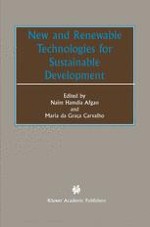2002 | OriginalPaper | Buchkapitel
Bioenergetics—Conversion of Biochemical to Mechanical Energy in the Cardiac Muscle
verfasst von : Samuel Sideman, Amir Landesberg
Erschienen in: New and Renewable Technologies for Sustainable Development
Verlag: Springer US
Enthalten in: Professional Book Archive
Aktivieren Sie unsere intelligente Suche, um passende Fachinhalte oder Patente zu finden.
Wählen Sie Textabschnitte aus um mit Künstlicher Intelligenz passenden Patente zu finden. powered by
Markieren Sie Textabschnitte, um KI-gestützt weitere passende Inhalte zu finden. powered by
Life is sustained by the continuous conversion of biochemical energy to mechanical energy, which is required to maintain the various functions of living organisms. This wide range of energetic activities depends on rotary and linear molecular (protein) motors of nanometer scale, which propel (bacteria, sperms), transport (messengers in neural network, cell division) generate high-energy metabolites (ATPsynthase) and perpetuate motion (muscle shortening).This study relates to the linear molecular motor, myosin, which is energized by ATP (adenosine triphosphate) hydrolysis, and actuates muscle filament contraction. The actin-myosin filaments make up the intracellular contractile apparatus, the sarcomeres, and their relative motion, sliding one over the other, determines the functional characteristics of the contracting heart muscle.The study explores the relationship between the biochemical energy consumption and the mechanical output of the motor units of the heart muscle. The analysis is based on coupling motor unit dynamics with free calcium binding kinetics, which regulates the motor unit activity. The calcium binds to the regulatory proteins of the contractile filaments and regulates the number of activated myosin motor units. The analysis quantifies the conversion efficiency and the determinants of the muscle’s economy. The intracellular interplay between efficiency and economy determines the adaptability of the heart muscle to the prevailing loading conditions. The analysis highlights the intracellular mechanisms and the adaptive processes that allow the heart to optimize its function under various loading conditions.Whereas the thermodynamic efficiency of the overall metabolic transformation from biochemical energy to mechanical energy of the whole organ is 25–35%, the efficiency of energy transduction from ATP to mechanical energy ranges between 50 to 70%. This high efficiency of energy conversion reflects the extremely high efficiency of the myosin motor unit, wherein the ATPase enzyme is instrumental in ATP hydrolysis ATP + H2O ↔ ADP+P reaction and the production of mechanical energy. Finally, we discuss the notion that man is challenged by nature’s functional design in his pursuit of new horizons.
